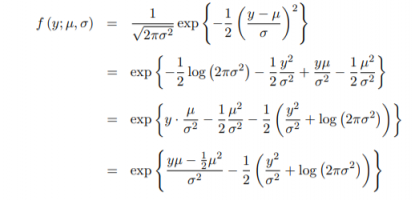Hi all. I'm having trouble changing an equation to a different form. I have been given the formula:
[math]f(x; \mu, \alpha) = \sqrt{\frac{1}{2{\pi}{\alpha}x^3}}exp(-\frac{(x-µ)^2}{2{\alpha}{\mu}^2x})[/math]
I want to convert it to the form below or as close as possible:
[math]f(x; \mu; \alpha) = exp(\frac{x\mu - b(\mu)}{\alpha} + c(x, \alpha))[/math]
I get to this point and then am not sure how to reach a form that is closer to matching the preferred form:
[math]f(x; \mu, \alpha) = exp(-log (\frac{1}{2{\pi}{\alpha}x^3}) - \frac{x^2 + 2x{\mu} - {\mu}^2}{2{\alpha}{\mu}^2x})[/math]
[math]f(x; \mu, \alpha) = exp(-\frac{x^2 +2x\mu - \mu^2}{2\alpha\mu^2x} + log(\frac{1}{2\pi\alpha x^3}))[/math]
Ideally I would want to end up with something similar to this, but I'm just not sure how to get there :
[math]f(x; \mu, \alpha) = exp(- \frac{x\mu - 2\mu}{\alpha^2} + log(\frac{1}{2\pi\alpha x^3}))[/math]
Any help would be greatly appreciated. This isn't my area of strength so I may have made one or more silly mistakes along the way but I'm happy to have them pointed out!
Thanks
[math]f(x; \mu, \alpha) = \sqrt{\frac{1}{2{\pi}{\alpha}x^3}}exp(-\frac{(x-µ)^2}{2{\alpha}{\mu}^2x})[/math]
I want to convert it to the form below or as close as possible:
[math]f(x; \mu; \alpha) = exp(\frac{x\mu - b(\mu)}{\alpha} + c(x, \alpha))[/math]
I get to this point and then am not sure how to reach a form that is closer to matching the preferred form:
[math]f(x; \mu, \alpha) = exp(-log (\frac{1}{2{\pi}{\alpha}x^3}) - \frac{x^2 + 2x{\mu} - {\mu}^2}{2{\alpha}{\mu}^2x})[/math]
[math]f(x; \mu, \alpha) = exp(-\frac{x^2 +2x\mu - \mu^2}{2\alpha\mu^2x} + log(\frac{1}{2\pi\alpha x^3}))[/math]
Ideally I would want to end up with something similar to this, but I'm just not sure how to get there :
[math]f(x; \mu, \alpha) = exp(- \frac{x\mu - 2\mu}{\alpha^2} + log(\frac{1}{2\pi\alpha x^3}))[/math]
Any help would be greatly appreciated. This isn't my area of strength so I may have made one or more silly mistakes along the way but I'm happy to have them pointed out!
Thanks
Last edited:

